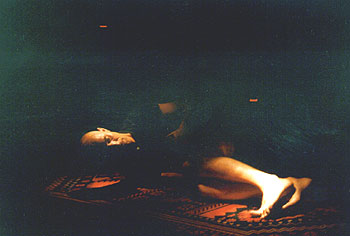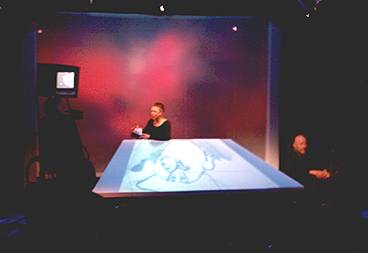BAFA © 2010. All material here is copyrighted. See conditions above. |
Roberto Lun
dancer/choreographer, Italy
|

|
Interviewed by Jacqueline Wassen, The Netherlands.
I am a choreographer who uses and gives workshops in a movement technique known as Contact Improvisation. Here the emphasis is on contact with other performers and the ground -to touch points, rather than on moving through the air. There isn't a main dancer with minor dancers but all the performers are equal in they way you work together. The idea is not to grab a wrist to make a particular movement, but to take and limb along or to move against a limb in such a way that the other dancer can move along or away. In this way there is a lot of freedom, not only to improvise but for various performers to move with and against each other.
Contact improvisation is a mix of theatre and movement so it is not accurate describe it as dance or theatre. The focus is on exchange rather than form. Another aspect of Contact Improvisation is the idea of always learning as well as teaching. I attend various workshops and give these as much to learn as to teach. It is a dance form that is always developing.
|
Other aspects of my choreography is the dramatology of the moving image and the idea of theatre as an extension of video. For example the piece "Magister Ludi", began with an actor's presence being only visible on the television monitor on the stage. Later when the actor sits in a wheelchair, his face is filmed and shown on the television monitor above the wheel chair. Projection and projected image are in a sense dislocated and change their roles. The video is sometimes part of the theatre like a prop and sometimes active like an actor.
I was brought up in Bolzano in north Italy, by a German mother and an Italian father. Then I worked as a furniture-maker for small businesses for 11 years. I saw a performance by a local Jethro Tell-like rock group, where some pantomime was involved and then approached them and they invited me to join them. It was crazy, because I was shy and had no background nor training.
|
|
After two years of doing these pantomime performances I decided to devote myself to theatre and so at the age of 27 I moved to Milan in 1985 to study dance, theatre, voice and circus technique. Another big change was adjusting to an irregular income. After my first year of part-time study, I got a job as a butler in a soap opera for a local television station. After two years of this, the bright lights damaged my vision so now I need to wear glasses, and I stopped this work.
One of my first challenges in learning dance was how to use my body, an 'old' body that had not had training from childhood. So I started in dance techniques such as Limon (a dance technique where the focus is improvisation). Cunningham, Graham, Stimme (with the Roy Hart Theatre London) and Jazz. Alito Alessi focussed on a dance form for those with various physical handicaps as well for those without.
It was hard work, disciplining and training my body, and at the same time, the dance world is a highly competitive one, where in general, striving for perfection dominates over improvisation. And likewise with the classes in mime, where study was aimed for the best and everything was focused on repetition and rehearsal rather than the experimental. I also found that many contemporary dance techniques, while changing the art of movement, didn't change its philosophy. It aimed to push the limits of the body or the use of opposite movements, rather than to open up the body from within.
In New York in around 1972 there was an explosion of new things in the dance world, and this spread to the dance scene in Berlin (De dansfabriek) and in Amsterdam (School for New Dance Development) [NOTE: There were articles about "The Connected Body" symposium hosted at this school in the March 1995 Arts Dialogue]. Choreographers such as Toolatan, Steve Paxton, Bill T. Jones found ways to connect the body to many sources where the body was used but not stressed towards some limit, such as in jazz, Eastern dance forms and music. This sort of dance involved using space more so that it became more sculptural and the venue was no longer just the stage or where the spotlight shone....
...My 'Rolling Points' workshop was aimed for a general audience, because I had no idea who was coming. I also do workshops for special groups such as disabled people, children or dancers. My aim is to get the students to feel their bodies and in feeling
their changing balance, rather than to concentrate on moving through space. I used the balls to help people to learn to move by just changing their weight and for safety. A ball is softer than another body, but later the aim is to develop the same level of trust in your body when working with each other.
My main income comes from freelance performance work and sometimes this is interesting, such as when I can use my own ideas or learn from others. Sometimes it is interesting to be part of a big show to see how things can be done in theatre when there is a lot of money available, and to be aware of the possibilities. Just recently I was commissioned to perform some slow acrobat movements for Italy's most known opera company (the Scala of Milan) when they performed in Sicily. Currently I am doing mime and dance for the Opera Don Giovanni for the Scala of Milan. There are lots bright costumes and it's a source of income. In 1995 I toured with the same company in Verdi's opera 'Falstoff and Traviata' in Japan, and while in Tokyo I gave a workshop on Contact Improvisation.
|

Dance/theatre piece Roberto Lun performed in Austria, 1997.
Photograph by Sonja van Kerkhoff,
The Netherlands.
A dance/theatre piece Roberto Lun performed at the Crossing Borders Symposium in Villach, Austria in August 1997. The only sources of lighting came from two hanging torches. He began, standing in the darkness behind the torches, by telling us in German that he was going to dance a tango. The music he said, produced on the CD, was made in Japan and made without feeling. Continuing in slap-stick manner, he told us that while not performing he would communicate in German and when he was performing, he would use the language of feeling -Italian. In Italian he continually argued emotively with himself, his body parts and his past. The piece was a mix of the absurd, the clever and the beautiful - awkward postures seemed continuously to evolve seamlessly into graceful ones and back again. This was his first piece of improvisation using voice.
| 
| But I enjoy working with semi-professional theatres best where the people I work with often have full time work in completely different fields. I enjoy the challenges of working with people from many different backgrounds along with my own ideas. My choreography isn't just about dance but more about issues where I often work people with diverse artistic or physical abilities.
For example, the dance comedy "Blind schön, dich wiederzusehen, oder nur Blinde Kuh" (Blind beauty, your second sight, or just a blind cow) was commissioned by a theatre company in Bolzano, Italy in 1997 where I worked 4 dancers and 1 video artist.
Often my titles contain ambiguous associations of touch, of the absurd, and sometimes this sense of the absurd is expressed in the performance such as when for this piece, two television monitors at each end of the stage showed news items while in the middle the dancers moved abstractedly without knowing what was on the monitors. It was as if the dancers performed in their world without an awareness of what was going on in the world at large. This piece then went on tour for 3 months. I had read a book about a man going blind, where he described his changing sight. In response I worked on a question and answer dialogue, in the form of a comedy where the blindness is perceived not so much as a loss but as a change. In the piece as the theatre progressively darkens, other senses, such as smell and sounds are stimulated.
|
For example, food is cut on boards, and the sounds and the smells dominate. The piece is as much as about literal blindness as psychological blindness. In my research for this I spoke with blind people in institutes for the blind. I was especially interested in the jokes they made with each other and how they expressed humour. Then blindness was given a literal meaning when the dancers were blindfolded. Now Contact Improvisation was necessary because the dancers had to touch as a means of sight.
Generally my sources of inspiration come from reading and a main thread concerns 'misunderstandings', people not listening to each other, people not respecting difference, or about war and in particular male/female mis-communication. Generally the pieces are fragmented incorporating movement, lighting, visuals, sound, video, and quite often the main narrative is not an obvious one. I also organise events and in 1994 co-ordinated a European Jam symposium for contact improvisation, in Bixon in North Italy.
Another piece I have choreographed is, 'Medea "Good Girl" ' 1 for a theatre festival in Austria for four dancers, where one woman performed as a young Medea and the other an older Medea. In the performance it became clear that Medea had various reasons for her actions and in this I wanted to show that there no such thing as good vs bad or a black and white world. Instead I wanted to show that in life there is a lot grey.
I live in Milan but actually most of my own choreography is performed in theatres in smaller places. There seems to be openness to more experimental forms of theatre than in Milan.
The project I am working on currently is inspired by the text Loflied der Zofheid by Erasmus (a philosopher from Rotterdam). A main theme is political dishonesty and half-truths. For this piece handicapped people will be the main characters - we often think handicapped can only mean limited or particular ways and I want to explore this half-truth.
Excerpts, Arts Dialogue, October 2000, pages 3 - 4
|
- Photograph: of his theatre, Magister Ludi, Arts Dialogue, June 2001
- Artist Profile: Arts Dialogue, October 2000
- Photograph: of his theatre, Magister Ludi, Arts Dialogue, June 1999
- About: his theatre, Magister Ludi, Arts Dialogue, June 1999
|

Arts Dialogue, Dintel 20, NL 7333 MC, Apeldoorn, The Netherlands
email: bafa@bahai-library.com
|
|


 Dance/theatre piece Roberto Lun performed in Austria, 1997.
Photograph by Sonja van Kerkhoff,
The Netherlands.
Dance/theatre piece Roberto Lun performed in Austria, 1997.
Photograph by Sonja van Kerkhoff,
The Netherlands.